|
|
Post by codystarbuck on Oct 15, 2016 19:54:28 GMT -5
Okay, so, getting into the spirit of things here, I thought I might try my hand at a review thread. Now, if this has been covered before, my apologies. I tried a search and didn't see a result. If it has, though, this is my take on things. Let me start with a bold statement I made in my "introducing myself" post, on the community page: "Manhunter is the greatest American adventure comic of all time!" That's a pretty lofty statement; so, can I back it up? That's what I hope to accomplish here. Let's start with the cover to the Baxter format reprint:  Now, does that say action & adventure, or what? We have helicopters, machine guns, intriguing women, ninjas......what else could you need? Well, how about the premise: Interpol agent Christine St Clair is investigating stories of a man who seems to either be an assassin and terrorist, or a hero. He seems to die repeatedly, only to be seen again, either trying to kill someone important or rescuing them from an assassin. It doesn't make sense. When he seems to die, the body disappears. She travels the globe, tracing threads from the stories, traveling to Nepal, collating information from Calcutta, the Middle East, South America, and Zurich. She eventually tracks down this phantom in Marrakesh and hears his story. Then, she is caught up in his activities. He's a man who appeared at a bank 30 years after establishing an account, looking impossibly young, yet can prove his identity via his fingerprints. His name is Paul Kirk. He was a big game hunter. He turned his hand to hunting human prey, as a masked crimefighter. he worked for the US government, behind enemy lines, during WW2. What is the secret behind this man? Still interested? Now, let's look at the creators. Archie Goodwin was the editor of Detective Comics, in 1973. He had made a name for himself at Warren, both as an editor and writer, as well as writing Secret Agent Corrigan, with Al Williamson and Carlos Garzon, for newspapers. This is a man who knew how to write action and adventure, especially old fashioned pulp adventure. Archie was working freelance for DC, editing three war comics. Carmine Infantino asked if he would try his hand at reviving the flagging sales of Detective Comics. As Archie said in the intro to the Manhunter special, this is a win-win situation, for a creator. If you succeed, you are a hero; if it fails, well, it was going down the drain already. What have you got to lose. Now, Archie couldn't really do much with Batman that was new and different, without getting a lot of political clearance. What he could do, though, was try some new blood on the stories and experiment with the back-ups. Archie said he liked more obscure heroes and he was drawn to the Simon & Kirby Manhunter, when he saw reprints in New Gods. That was where the idea was formed. He had seen Walt Simonson's work when he was trying to break in and gave him some work on science fiction comics. Walt wanted to do more and Archie gave him a back-up story in a war comic, about the Battle of the Alamo. That showed him that Walt could draw anything and planted the seed that led Archie to approach him about Manhunter. They worked together to develop the character and turn him into a modern ninja (a relatively new term, in pop culture), but came up with a costume that looked more like a samurai. They chose bright colors to contrast with Batman's. They gave him all kinds of exotic weapons and a healing factor, before a certain Canadian came along. from there, they launched a legend, with a simple blurb, at the bottom of Detective Comics #437:  |
|
|
|
Post by codystarbuck on Oct 15, 2016 20:36:12 GMT -5
So, despite a rather subtle intro on the cover, Archie and Walt went to town on the first page:  Archie sets the mood with the opening narration: "Nepal! In the shadow of the Himalayas lies its capital, Katmandu. Here, at the city's great Northern Gate, where in older, simpler times caravans arrived from Tibet, sits Haj the Ancient. Day by day, year after year, he is here, collecting sight and sound, tale and rumor as some might rare coins or stamps. Those who would know of another's passing through the city come sooner, later, to Haj." Walt gives us a view of the great gate and the massive mountain chain beyond. We see the ancient bearded man, wrapped in a cloak and hood, face hidden from us. We see young Interpol agent Christine St Clair pay for information about a man called Manhunter, and we end with a colorful figure, draped in shadows, being menaced by thieves and murderers, drawing weapons from behind their back. The masthead says it all: He Stalks The World's Most Dangerous Game!" This is storytelling. In just four panels and a few sentences, we have our principles in an exotic corner of the world; a land steeped in legend and mystery. We are told what we are about to hear is a revealed secret, about a name being whispered. Manhunter! We see a colorful figure; but we only get an obscure glimpse. You are compelled to turn the page to see what is about to happen and learn more about this mysterious man. This is pulp storytelling, from a master. This is eye-capturing art, from an extremely talented rookie. Then, we turn the page. Manhunter is tracking a man who was given protection by the Cult of Thieves and he is about to learn what that protection means. Violence explodes. manhunter systematically takes out four opponents, with hand, foot, knife and pistol. Everything is a weapon to him. He gets information from the fifth, living man. Christine identifies this Manhunter as a man named Paul Kirk. Haj cannot confirm; but adds to his tale. A man was seen near a buddhist monastery, protected by zen archers. The man disappeared, when guardians sought to catch him. Later, a figure approaches the monastery at night at night. He distracts the archers and enters the grounds. He bests 2 of the three archers, but one has a bead on him. Can he best 3? He arrives before his prey, with arrows sticking out of him and then pulls out a pistol and silencer, then proceeds to take out a crowd of robed men, who are attacking, leaving the dead behind. They are assassins, out to kill Manhunter's prey, a political exile. He looks at the men and sees that they have the same face as Manhunter. Haj concludes his tale and Christine St Clair moves on to follow the thread. Haj stands up and removes his robe and beard, revealing a red costumed man, underneath. Manhunter. In 8 pages, Archie and Walt have told an epic tale of intrigue and violence, and have whetted the appetite to know more. Readers may have picked up this comic because Batman is facing a masked man in a robe, with a sword; but, they are probably coming back for the next issue, because of the red-clad ninja who took out a gang of armed thieves and murderers, 3 zen archers, plucked arrows out of his chest, and killed a hoard of robed men, who all wear blue masks and have the same face. Especially after they see that this mysterious Manhunter is the one who just told St Clair the story. You have to know what happens next. Walt uses the panel layouts of the page to speed up and slow down the action. In the fight with the Cult of Thieves, we see the 4 dispatched in single panels, each emphasizing the strike. One is punched in the gut, one has a knife thrown at his chest, one is kicked in the midsection, and one is shot, his own pistol falling from his hands. Walt gives us scenic vistas, and dank alleys, monasteries and rooftops. Six panels, in a single row, are used to demonstrate the skill of the zen archers. Three show the archers drawing their bows, three in the middle show a closeup of their blindfolded eyes, their drawn arrows, and their sure stance. then, three show the arrows perfectly hitting the target. Thus, when we see a shadowy figure jump down from an overhang, to the monastery wall, we know he is in trouble. In one page, we see Manhunter best 2 of the 3, showing his skill; but, the third has him dead to rights. One page, 9 panels. Walt gives us a shot of the prey, then a closer view, then even closer. This doesn't look like a threat. Walt goes from serene monk's face to the arrow riddled body of Manhunter. Peace meets violence. Manhunter draws his weapon and attaches a silencer. We know his prey is doomed. Walt sets us up to expect the kill. Then, we see Manhunter push the monk out of the way and attack a crowd of robed men, men we believe are monks. Monks carrying guns. One man wipes them out. Walt gives us the highlights, while Archie gives us the salient points in terse narration and dialogue. At the end, we are left with why did this man save the monk? Why did these others want him dead? Why do they look alike? Where will Christine go next? Why did Manhunter, in disguise, tell her all of this. This is how you set up a mystery. Throw people into the situation, give them some clues to follow, set up their expectations and then turn them on their head. Then leave us with more questions. You have to have answers. This is just the first chapter. Some comics would have carried this over 6 issues. Archie and Walt do it in 8 pages, in the back of a book starring Batman. It's like putting the opening of a James Bond film at the end of an episode of the Rockford Files. The main story is still good and features a great character; but, the follow-on is on a whole different level. |
|
shaxper
CCF Site Custodian
Posts: 22,873
|
Post by shaxper on Oct 15, 2016 21:10:10 GMT -5
FANTASTIC choice for a thread! I read the run a few years back and didn't love it as much as I'd hoped to, so I'm enjoying reading your perspective on the matter. I will have to go back for a re-read.
|
|
|
|
Post by Deleted on Oct 16, 2016 21:22:18 GMT -5
This character fascinates me and I really wanted to know more about him. I will be looking forward seeing further reviews and if you have any books that both Goodwin/Simonson did please share.  |
|
|
|
Post by codystarbuck on Oct 16, 2016 21:45:53 GMT -5
Well, one of the biggest projects they did together was the Alien graphic novel adaptation, for Heavy Metal. That was a thing of beauty and got distributed to mainstream bookstores. Walt also drew Star Wars #16, "The Hunter," where Archie introduced Valance, an ex-stormtrooper turned bounty hunter, with an extreme hatred of droids. The character became a major player in Archie's stories, leading up to just before Empire Strikes Back. I'm not sure what all they did together, without doing a lot of digging; but, I know those were major ones. It's a shame that Walt didn't have the regular penciling gig on Star Wars, as he was perfect for it (just look at his Star Slammers). I liked Carmine Infantino, though he was often off model on a lot of elements in the series and his work had gotten very angular; but, he told dynamic stories, which fit the tone of Archie's stories.
|
|
|
|
Post by codystarbuck on Oct 16, 2016 22:12:53 GMT -5
I'm a bit worn out, so I'll get to chapter two tomorrow (or the next day); but, I wanted to take a moment and look at the design of Manhunter. The original Simon & Kirby Manhunter looked like this: 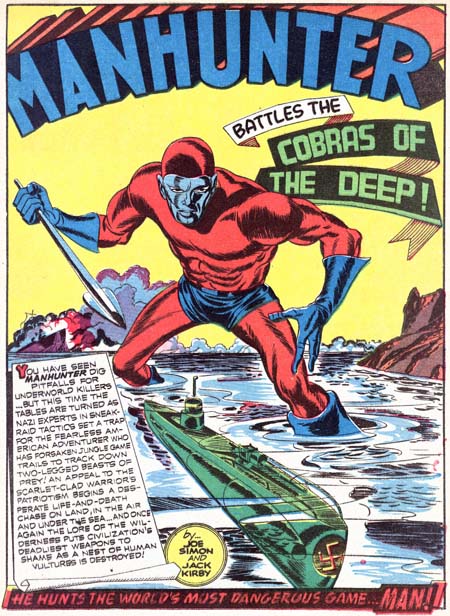 His costume was a bit unique, in the world of mystery men. The trunks and buccaneer boots and gauntlets were standard issue (especially Simon & Kirby standard issue) and the red longjohns are the regulation kind. The mask is where he was different. While most heroes wore domino masks, hoods, helmets, cowls, or some similar contrivance, Manhunter had a solid, blue, theatrical-style facemask. It gave him a frozen look (though S&K made it look pretty much like a normal face and changed expression). Walt and Archie didn't stick with that. We get to see it, sort of, in the chapter where Paul Kirk relates his history, when he and Christine finally meet face to face (without disguises). I'll get to that in a moment. They came up with a new one. 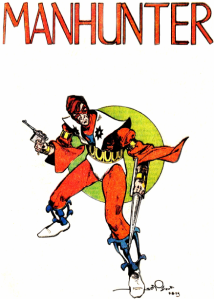 They were looking for something that said ninja, but with bright, primary colors. Walt tweaked it a bit, adding more samurai touches than ninja. The white jacket is a stylized version of a the "surcoat" that Japanese samurai wore over their clothing, in formal occasions. It was usually emblazoned with their "coat of arms." Manhunter also got a red shirt with voluminous sleeves, anchored by gold armband at the biceps. The coat and shirt added dynamic movement to the character, much as a cape does to Batman and Superman. His white boots are covered by blue metal rods, linked together, with little points on the bottom. These were climbing spikes, much like a lumberjack or telephone lineman would wear. They also served as storage for his edged weapons (more in a minute). Instead of the full face mask, Paul Kirk has a red hood, with exposed top, allowing his hair to flow. He wears a blue harness, under the white jacket. The Manhunter clones would wear a blue bodysuit and mask, with white boots and harness, in contrast to Paul. Paul accessorized with a metal waistbelt and gold wristbands, making it work, as Tim Gunn would say. Now, the weapons. What's a ninja without throwing stars? Walt gave him two, carried on the upper area of the jacket, providing both decoration and a mode of attack. In his leg bands, he carried two blades: a throwing knife (on his right side) and on his left a katar (a Hindu punch dagger). Walt got the scale a bit off and made the thing as big as a sword, when real ones are about the size of a dagger. Archie gave it the wrong name, calling it a "bundi dagger." This was a unique weapon in comics and made Manhunter instantly recognizeable. It would be some years before we saw Katar Hol (Hawkman) carrying the weapon that bore his name. Topping off the weapons was a Mauser pistol, with silencer accessory, carried in a holster on the blue harness (at the small of the back). The Mauser was always an exotic pistol (Churchill carried one, in his younger days) and had a memorable silhouette. Howard Chaykin would give one to Dominic Fortune, Dave Stevens had one come into Cliff Secord's hands, Mike Grell gave one to Jon Sable, and the gang at Lucasfilm used it to build Han Solo's blaster. Everything about Manhunter said exotic. By contrast, the clones, apart from wearing similar uniforms, in blue, used fairly mundane weaponry. Only Asano Nitobe, the ninja master who trained Paul, had a unique outfit. Christine St Clair favored jumpsuits and field wear, with pistol and holster accessories, from the Modesty Blaise line (though in a nice green, rather than black). Manhunter looked like no other character in comics, further cementing the greatness of this series. |
|
|
|
Post by codystarbuck on Oct 16, 2016 22:31:40 GMT -5
Now, about that original facemask. It would be a source of of some compounded mistakes. In his debut story (as Manhunter, Paul Kirk previously appeared as a detective, specializing in missing persons), there is a miscommunication about the mask. On the cover, he is wearing a red hood mask. Inside, we see the same, except, you can see that wasn't Simon & Kirby's intent. 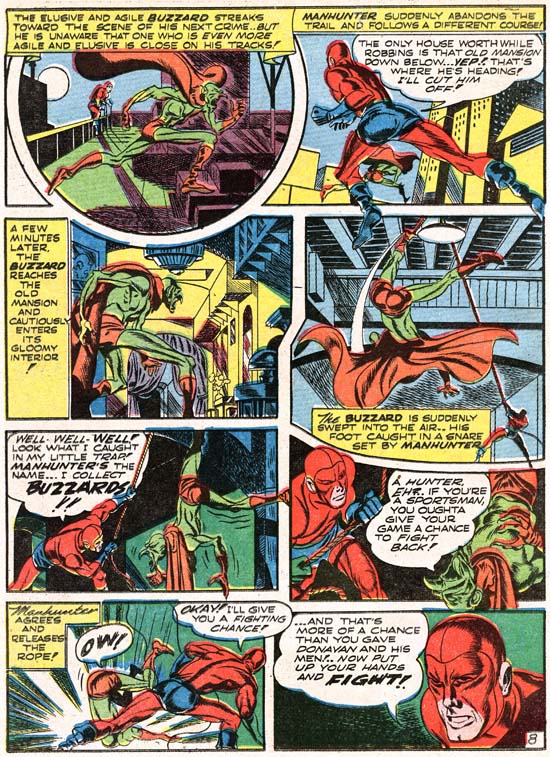 As you can see, they drew the line for the blue facemask; but, it is colored red, down to the nose and chin area. I've never seen a definitive answer; but, I suspect the cover was done first, but they made changes within the story and then the art was corrected before production (though after it was inked). In the next issue, we have the familiar blue face mask. When Walt drew the flashback, with the old costume, we see this: 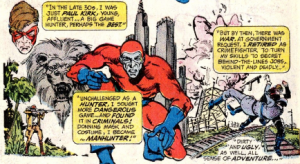 Notice that Walt has drawn both the outline of the blue face mask (look at the forehead) and the openings of the red hood, for the eyes, nose and mouth/chin. It was colored blue, in Detective #439, looking like Walt got confused, drew it based on the original Manhunter appearance, and someone at DC had the colorist fix it. So, we have the mistake in two directions, in the beginning, where the blue mask is gone, covered by red coloring; and, later, with a mask drawn in, but colored blue. Get ready for the next correction.  This is from the 1984 Baxter reprint special, with the complete story. You see the coloring has been corrected to have the red hood, a blue area around the face holes, but flesh-colored exposed skin. This is the version reprinted in the Manhunter trade paperback. Can you imagine the field day fans would have had, if the comic had been produced in the internet age? "You guys messed up the costume!" "What's up with the mask?" It's reminiscent of Rob Liefeld's early Image work, where costumes would change from page to page. It's an element of the series that has always amused me. |
|
Confessor
CCF Mod Squad
Not Bucky O'Hare!
Posts: 10,211 
|
Post by Confessor on Oct 16, 2016 23:31:29 GMT -5
It's a shame that Walt didn't have the regular penciling gig on Star Wars, as he was perfect for it (just look at his Star Slammers). Walt Simonson did eventually get the gig on Star Wars though: he was the book's regular artist from issue #49 to #66. That was with David Michelinie writing though, not Archie Goodwin. However, Goodwin and Simonson worked together on the second Star Wars serial to appear in Pizzazz magazine, titled "The Kingdom of Ice". I review all the Simonson issues of Star Wars, including issue #16, and Pizzazz here, if you're interested... classiccomics.org/thread/1039/star-wars-marvel-reviews-confessor |
|
Roquefort Raider
CCF Mod Squad
Modus omnibus in rebus
Posts: 17,423  Member is Online
Member is Online
|
Post by Roquefort Raider on Oct 17, 2016 10:48:08 GMT -5
Hah!!! I didn't know the robotic manhunters from Millenium were inspired by a Golden Age character! Thanks, codystarbuck!
|
|
|
|
Post by chaykinstevens on Oct 17, 2016 12:19:55 GMT -5
Goodwin and Simonson also collaborated on the Close Encounters of the Third Kind adaptation in Marvel Comics Super Special #3 and part of Star Wars #50.
|
|
|
|
Post by codystarbuck on Oct 17, 2016 23:41:58 GMT -5
It's a shame that Walt didn't have the regular penciling gig on Star Wars, as he was perfect for it (just look at his Star Slammers). Walt Simonson did eventually get the gig on Star Wars though: he was the book's regular artist from issue #49 to #66. That was with David Michelinie writing though, not Archie Goodwin. However, Goodwin and Simonson worked together on the second Star Wars serial to appear in Pizzazz magazine, titled "The Kingdom of Ice". I review all the Simonson issues of Star Wars, including issue #16, and Pizzazz here, if you're interested... classiccomics.org/thread/1039/star-wars-marvel-reviews-confessorI really kind of fell out of reading Star wars, after the Empire adaptation, though I had up to 50. I really wanted more of Walt when Archie got to play more with the toys, before Empire changed the direction of things. The problem of Han on ice kind of killed the momentum of the comics, for me. Walt did get to have some fun with Battlestar Galactica. |
|
|
|
Post by codystarbuck on Oct 17, 2016 23:44:35 GMT -5
Mausers? How could you forget about me?!  Also, like Han Solo, there's this guy.  Back to your regularly scheduled programming. Yeah, I forgot about poor Mike. As for Dredd, I never looked at the Lawgiver and thought "Mauser." It always looked more like a hot glue gun, to me |
|
|
|
Post by codystarbuck on Oct 18, 2016 0:38:45 GMT -5
Now, back to our show. When we last left Christine St. Clair, she was walking away from Haj the Ancient, who related the tale of Manhunter's battles in Nepal, only to be revealed, to us, to be Manhunter, himself. Did he feed her a yarn or can this guy pluck arrows out of his chest like they are splinters and defeat crowds of killers? Time for some answers. 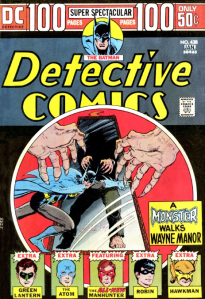 As we see on the cover of Detective #438, Manhunter has graduated to getting his face on the cover. Of course, this is the start of the DC 100-PG issues of the book, with new Batman and Manhunter stories and reprints of other tales. he's in lofty company, with Green Lantern, the Atom, Robin, and Hawkman and he is dead center. 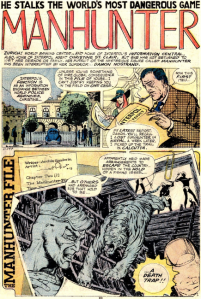 Our story begins in Zurich, where Christine St Clair, in more urban clothes (and a big hat) is relating more info about Manhunter's activities, to her boss, Damon Nostrand. She tells of a tale from Calcutta, where Manhunter is travelling via ship, and has a tiger dumped in the hold, where he is resting. This is where Walt breaks out the katar, or "bundi dagger," as Archie calls it. We watch the tiger strike at Manhunter, see him make some narrow escapes, while Archie tells us no one can take on a tiger barehanded. Then, Manhunter pulls out the katar and flashes it in the air, before plunging it into the leaping tiger's belly. Manhunter kills the animal, yet he sits there and watches it die, seeming to be filled with grief at the death of the powerful animal. Christine takes her tale back to the first report of Manhunter, or rather, Paul Kirk, in Zurich. Kirk, who opened an account in a Swiss bank in the 40s is back to claim the money, in the 70s, looking not a day over 30. How is this possible? Yet, fingerprints prove he is Kirk.This is all a group of thugs need to know, as they attack the departing Kirk. He quickly dispatches them, without mussing up his purple suit. I don't know if that was supposed to be a color effect, for mood, or a comment on 70s fashions. He does have some pretty wide lapels. Christine moves next to a story of an attempted assassination in the Middle East, which Manhunter interrupts, leaving one dead assassin (thanks to well placed shuriken throwing stars. The assassin matches Paul Kirk's description; but, the body is stolen from the morgue, before it is examined. We move to Brasilia, where Manhunter foils an attempted kidnapping of a Brazilian geneticist, while receiving multiple machine gun bullet wounds. He got better, as John Cleese would say. Forensics at the site show Manhunter had Paul Kirk's fingerprints, as did the attempted kidnappers. We finish with more whispers of Manhunter, sometimes hero, sometimes assassin. Christine's boss is convinced and tells her to keep investigating and sends her off to follow a lead in Marrakesh, while he safeguards the files. After she leaves, he burns them. Wha? Archie fills this issue with intrigue after intrigue, mystery upon mystery. We see more of Manhunter's prowess and are given evidence that he is Paul Kirk, a man who should be in his late 50s or even 60s, yet seems like a day hasn't passed. He kills tigers, assassins, kidnappers, shrugs off bullets (well, gets up after them) and takes out a helicopter with his Mauser. We learn that his enemies also seem to be Paul Kirk and that Manhunter displays a fighting style that matches the ninjitsu techniques of the last master, Asano Nitobe; a man who died at Nagasaki, in 1945. More mystery. Once again, Archie and Walt give us more story in 8 pages than most comics manage in 6 issues, these days. Letting Christine St Clair tell the tale helps establish her more as a character, as we learn of her investigations and her father, who is a banking official, who brought the tale of Paul Kirk to her attention. She convinces her incredulous boss that this isn't a fantasy and gets the go ahead to go to Marrakesh. He also, shows us there is a conspiracy at work, with this group of blue-clad Paul Kirks acting as assassins and muscle, against important men. We are teased at the end with the line; "Next: The Resurrection of Paul Kirk." You know we are going to hunt down that issue when it hits the stands (in two months, as Detective was bi-monthly, in this era)! Walt gets to shine, as well. He gets to draw Indian ships, with attacking tigers. He has Manhunter move with speed and grace, as he avoids the tiger, then draws his weapon. He has Manhunter display it for our eyes, before we see him use it, letting us take in the exotic weapon, then gain a respect for its deadly nature. He convey's Paul Kirk's sorrow, as he kneels over the dying tiger, while Archie describes his sadness, then Walt shows a ship with men diving over the side, silhouetted in the moonlight, as Archie tells us he had less mercy for the men who set the tiger upon him. Walt also gets to play around with fashion and patterns. Damon Nostrand is wearing a plaid or checked sport coat, while Christine looks quite fashionable in her blouse, vest, skirt and boots, topped off by a snazzy hat (looking somewhat like an Aussie bush hat). Paul Kirk gets a sharp suit, while an assassin is seen in a bedouin burnoose. Walt also plays around with panel progressions again, a hallmark of the series.The action is sped up or slowed down by the addition or subtraction of panels (fewer panels for swifter action, more to highlight more action beats. The panels are cinematic in style, with long shots establishing setting, then tighter shots as action is taken. In the Middle Eastern scene, we see a car in the distance, then the assassin taking aim, with a rifle grenade. We see the grenade in flight and the car looming closer. Then we see a shot of a shuriken, then it impacting the grenade, diverting it in flight. Walt dispatches the assassin in 6 panels, all on one tier of the page. The assassin turns, holding his weapon (panel 1), we see Paul Kirk in the distance (2), a close-up of his face (3) he plucks a shuriken from his jacket (4) tight shot of his hand as he makes a throwing motion (5), and the assassin hit, his rifle flying from his hands (6). Manhunter's fights with the blue-clad kidnappers is far more terse, with quick shots of Manhunter's strikes, only to be shot up by a helicopter gunship. Walt then slows it down again as the gunship comes closer into view and the wounded Manhunter rises up, drawing his Mauser, attaches the shoulder stock, then fires at the attacking helicopter, destroying it in an explosion. Walt finishes the tale with a single panel montage of Manhunter fighting a blue assassin, holding a samurai's katana (sword) and a sai(3-pronged dagger, carried, later, by Elektra), a shot of the Mauser, and Christine standing to the side of the panel narrating. This montage tells us the story of numerous battles that modern writers would have dragged across a dozen issues. Walt, in interviews, fully credits Archie with the use of the panel layouts to control the tempo of the tale. He says he learned so much from Archie (who was also an artist). He also mentioned, in an interview (maybe the same, maybe another; I can't recall) that one of his artistic influences was Jim Holdaway, original artist on the British adventure comic strip, Modesty Blaise. As soon as he said that, I could see it. Holdaway used cinematic shots and had similar action beats, in had-to-hand fights. He had a similar line to Walt's, though Walt's would be assimilated with Kirby's dynamism. Here's an example of Holdaway's work, on Modesty Blaise:  Note the body language, the use of different angles, and the use of only essential lines (though more use of lines for tones, due to the black & white printing of the strip). Holdaway was one of the seminal adventure cartoonists and Walt definitely learned a thing or two. I would love to see him try his hand at a Modesty adventure. Too bad both Archie and Peter O'Donnell (creator of the character) aren't with us to write it. I'd bet big money that the inspiration for giving Manhunter a throwing knife rested with Willie Garvin's use of same in the Modesty stories (right down to the drawing of it). Next up, origins, big game hunting, ninjas, betrayal, and art mistakes. (Remember the mask?) |
|
|
|
Post by codystarbuck on Oct 18, 2016 11:58:33 GMT -5
Hah!!! I didn't know the robotic manhunters from Millenium were inspired by a Golden Age character! Thanks, codystarbuck! With a bit of a detour, yes. Jack Kirby revisited Manhunter (after Archie and Walt had their turn) in First Issue Special #5. There, he introduced Mark Shaw, who joins a secret society of Manhunters. At the start of the story, we see Manhunter take out a criminal, then remove his mask, revealing an old man. It's not clear; but, many assumed it was supposed to be Paul Kirk and Kirby ignored or was unaware of the most recent Manhunter. That was the only story Jack did. Steve Engelhart picked up on that in JLA #140. There, he latches onto the idea of the Manhunter Cult and puts them at odds with the JLA, with Mark Shaw caught in the middle. They are eventually revealed to be robotic creatures, created by the Guardians of the Universe as law enforcement. They became corrupted by a lust for power and were defeated by the Guardians and the Green Lantern Corps. This was then picked up, in the 80s, for the Millennium crossover event. So, the android Manhunters are really based on Kirby's 1970s revamp of his 1940s hero. Also, Paul Kirk was a different Manhunter, before he put on the red longjohns. He appeared in a strip, titled Paul Kirk, Manhunter, where he investigates missing persons cases. Simon & Kirby launched the new Manhunter hero by giving him a new name, Rick Nelson. Somebody wanted it to be Paul Kirk and that's who he is from the second story on. I guess Rick Nelson went to a garden party, to reminisce with his old friends, so Paul Kirk had to take over. |
|
|
|
Post by MDG on Oct 18, 2016 12:43:13 GMT -5
Another series I should re-read. I think I have all of the originals, as well as the 80s reprint. There's a fairly rare edition that came out in '79. I remember thinking at the time that $8.50 was pretty pricey for a B&W book. Not a DC product, so I don't know what kind of deal was cut for it. www.comics.org/issue/682152/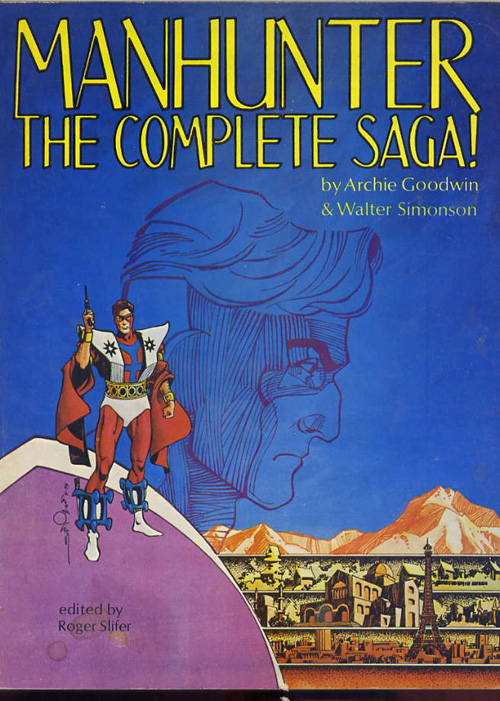 |
|





















